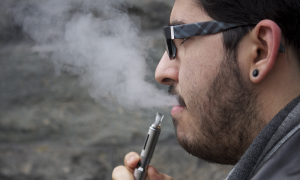
Juan Luis Tirado (COL ’16) smokes an e-cigarette. In their report, Cobb and Abrams called for FDA regulation of e-cigarettes.
Researchers at the Georgetown University Medical Center published a brief perspective urging the Food and Drug Administration to accelerate regulations that would decrease safety concerns of e-cigarettes in the New England Journal of Medicine on Oct. 16.
Nathan Cobb, an assistant professor at the Georgetown University Medical Center, and David Abrams, an adjunct professor at the Georgetown University Medical Center and Lombardi Comprehensive Cancer Center, also discussed the effectiveness of e-cigarettes as a means for smoking prevention in their article, “The FDA, E-Cigarettes, and the Demise of Combusted Tobacco.”
Cobb and Abrams gave evidence that e-cigarettes could work as potential nicotine-replacement therapy, finding significant potential for growth in the product’s market. However, the researchers acknowledged that some manufacturers remained unsafe, requiring FDA regulation to separate the harmful products from the nicotine-replacement mechanisms.
“We’ve spent decades trying to get nicotine replacement products, like the patch or gum, into the hands of more smokers to help them quit, but never achieved our public health goals,” Cobb said. “E-cigarettes, despite their flaws, are a potential path to do that but only if we can guarantee the public that they are safe and will help them stay off deadly combusted tobacco products.”
Regulating e-cigarettes would require manufacturers to disclose ingredients, register their products and restrict sales to young people. The FDA’s Center for Tobacco Products previously explained that in order for e-cigarettes to be advertised as smoking cessation products, they would also have to be approved as pharmaceutical products by the FDA.
“Getting a pharmaceutical product approved by the FDA requires millions of dollars in funding, an experienced team and years of time. The small existing e-cigarette companies don’t have the resources to do this, only the big tobacco companies that sell cigarettes do, and I don’t think they are interested in the best interests of health,” Cobb said.
In April 2014, the Food and Drug Administration announced their initial intention to regulate e-cigarettes, which have been on the market for eight years, to raise them to the same level of cigarettes.
The battery-powered devices dispense aerosolized and refined nicotine using a humectant and liquid nicotine. In 2014, Americans will spend $2.2 billion on the product, more than on nicotine-replacement therapies and significantly less than on combustible cigarettes.
“The combusted cigarette market is enormous because consumers buy a pack or more of cigarettes every day for decades due to their addiction,” Cobb said. “As long as e-cigarettes remain no more addictive than the nicotine patch or gum then the market will remain small; if manufacturers are allowed to create highly addictive devices and sell them to young people then the potential sales could be enormous.”
The report expressed hope, with more FDA regulation, more widespread use of e-cigarettes would limit the demand for cigarettes.
“We would encourage the FDA to accelerate their regulations to eliminate uncertainty regarding safety, drive the substitution of clean nicotine and hasten the demise of lethal combusted tobacco,” Cobb and Abrams wrote in the article.
Georgetown student Charlotte McCary (COL ’17) agreed, noting that e-cigarettes would be even more effective by closely mimicking the procedure.
“I’ve heard that one of the most difficult tasks for people trying to quit smoking is replacing the routine that accompanies it,” McCary said. “While patches and gum can chemically wean you off of the need to smoke, it doesn’t seem like they would be very effective in channelling the urge to go through the methodical motions of pulling out a cigarette, lighting it and relaxing for a few minutes until it burns out. I could see how e-cigs would be a better tool for people starting to quit because they don’t force you to change your routine right away.”
Despite the potential effectiveness of e-cigarettes in smoking cessation, Cobb expressed his uncertainty about the current products and hopes e-cigarettes will continue to progress.
“At the end of the day, we don’t know if e-cigarettes are good or bad because we don’t know what they are. If I walk into a 7-11 and buy an e-cigarette, there is no law that says it has to contain nicotine, or even which chemicals can be used to carry the nicotine,” Cobb said. “What we believe to be true is that a manufacturer can create e-cigarettes that are safe and could help people quit, but without regulation we have no idea if specific brands or models actually do that.”
This article has been updated.














